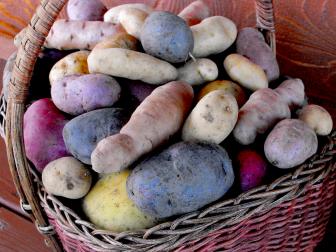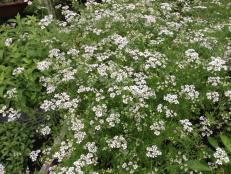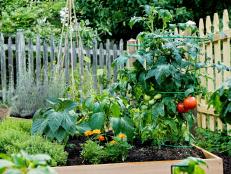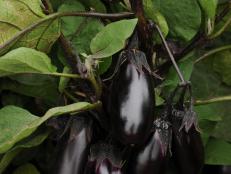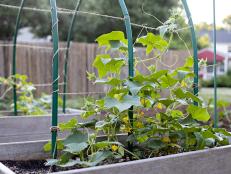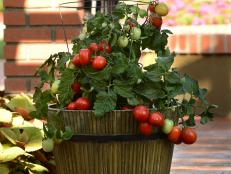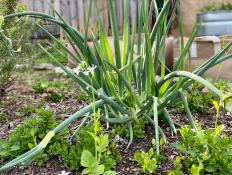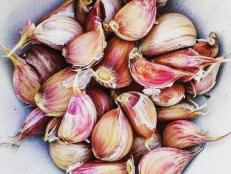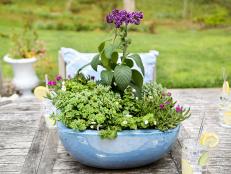Companion Planting for Potatoes
Discover best garden companions for potatoes, from beans to barley, plus get potato planting and growing tips.

Harvesting garden-grown potatoes feels a bit like unearthing buried treasure, and with a kaleidoscope of colors and sizes available, it can look like buried treasure too! Potatoes are easy to grow, and the flavor of a homegrown potato baked, boiled, scalloped or mashed just can’t be beat. Unfortunately, many modern varieties of potatoes are susceptible to a host of pest and disease pressures. Companion planting in combination with using good cultural practices and disease-resistant varieties will ensure a plentiful harvest of potatoes.
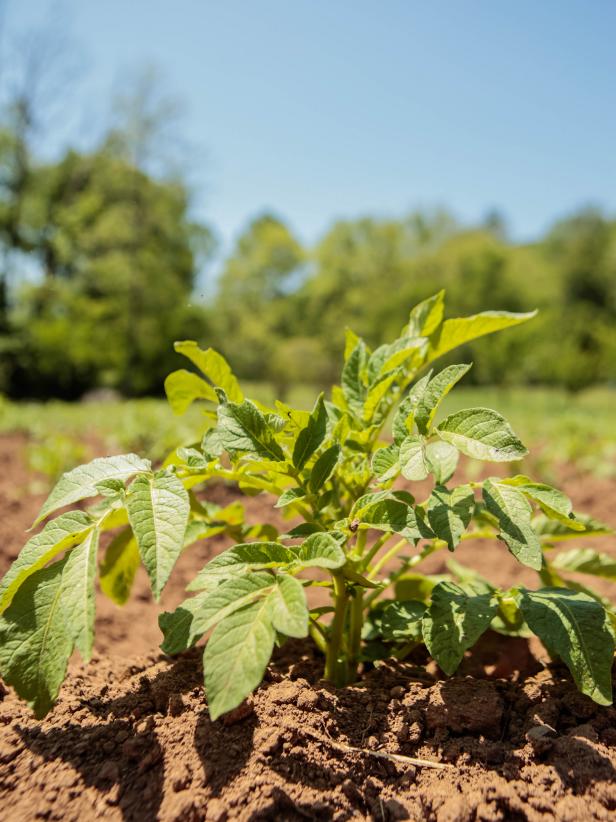
Photography by John Black, Scripps Networks Interactive, Location Courtesy: Blackberry Farm
Fingerling potato plants grow in the idyllic garden at Blackberry Farm in east Tennessee.
What is Companion Planting?
At its roots, companion planting is all about plant diversity. Gardens that only feature a handful of related crops tend to be more susceptible to pest and disease pressures than varied plantings where every member plays a different role. Sure, some diverse species compete for the same resources — like light, water and nutrients — but others can complement one another by filling different niches or even helping each other grow by improving soil quality and nutrition, attracting beneficial insects, or deterring pests of neighboring plants.
Potato Companions
To Improve the Harvest
- Potatoes grown with garden beans may produce larger tubers. Beans and other legumes partner with Rhizobium bacteria in the soil to capture nitrogen from the air. Beans are able to share this nitrogen with other crops when planted closeby. Jessica Walliser, companion planting expert and author of Plant Partners: Science-Based Companion Planting Strategies for the Vegetable Garden, recommends alternating rows of beans and potatoes or actually alternating species within rows.
To Control Pests
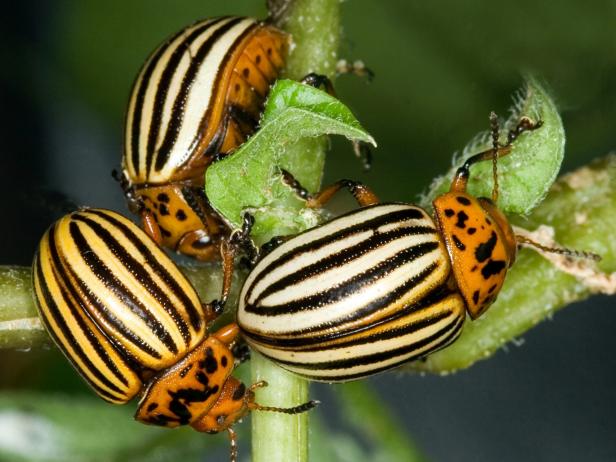
National Gardening Association
The Colorado potato beetle features black stripes down its back. Its a pest throughout North America and can quickly defoliate potato crops.
- Growing potatoes with healthy onion or garlic plants improves resistance to aphids. Researchers have found that plants emit volatile organic compounds (VOCs) both when they are damaged and when they are healthy. Not only that, but plants can detect VOCs emitted by neighboring crops and respond in how they grow. Potatoes respond to VOCs from neighbors by emitting terpenoid compounds that deter aphids.
- Planting the herbs tansy or catmint among potatoes can deter the Colorado potato beetle, a common pest. The strong fragrance of the foliage of these herbs masks the potato plants from the Colorado potato beetle, which relies (in part) on scent to detect the crop. In Plant Partners, Jessica Walliser points out that although there are some drawbacks to growing perennial herbs as companions to an annual crop that may be grown in a different area of the garden each season, tansy and catmint are tough plants that can handle being relocated.
- Large plots should include a strip crop to provide habitat for predators of potato pests. Alfalfa provides great habitat for predators of the Colorado potato beetle, and barley does the same for aphid predators.
To Control Disease
- Planting potatoes after a cover crop of oats or winter rye decreases pressures from Verticillium wilt. Beneficial mycorrhizae fungi will displace the Verticillium fungi in the soil. Incorporate the cover crop into the soil a few weeks before planting, or plant seed potatoes directly into the cover crop. If you choose to plant directly into the cover crop, note that oats will be killed by winter cold, but rye will need to be cut back when it begins to flower.
How to Plant and Grow Potatoes
Learn how to grow different types of potatoes in your garden, from planting to harvesting.
Tips for Growing Potatoes
Potatoes require a chilling period before tubers can form, which is why most gardeners plant their taters in the late winter or early spring. Southwestern gardeners may even start their crops in the fall. The planting date will vary by region, but many gardeners swear by planting potatoes when the yellow blooms of daffodil, dandelion and forsythia appear.
“Seed” potatoes aren’t true seeds at all — they are actually fragments of the potato tuber that include one or more buds (or “eyes”) that grow into the plant shoots. Look for seed potatoes that are certified disease-free to prevent introducing any new diseases to your garden. You can choose your varieties based on days to harvest, size of the tuber or (importantly) how you prefer to prepare your potatoes.
Growing potatoes in the garden is fun and relatively easy to do. Plant seed potatoes 4 to 6 inches deep and roughly a foot apart within a row. Leave three feet between rows to ensure there’s enough room for tubers to develop and for companion plants to grow. Potatoes grow well in bags or containers, so don’t be discouraged if you don’t have traditional garden space.
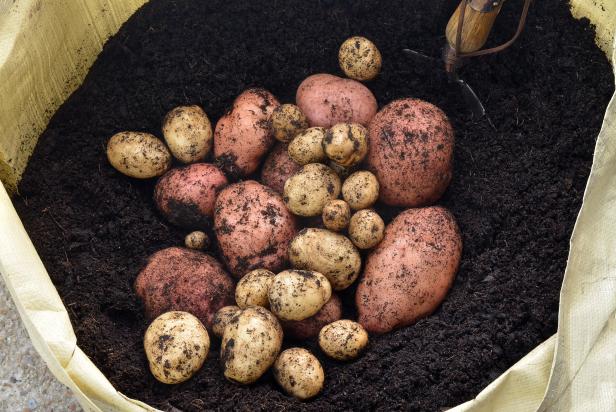
Shutterstock/Deborah Lee Rossiter
Potatoes can be grown in a small space and on a small scale in any kind of bag that holds at least two or three gallons of soil. Because it is inexpensive, simple and interesting, growing potatoes in a bag is a method often used by teachers in school gardening classes.
Whether grown in the ground or in a pot, potatoes need moist but well-drained soil that is rich in organic matter. Compost-rich soil provides nutrients, improves drainage, and retains water too. As potatoes grow, cover the developing shoots with soil, compost or straw for easy harvesting.
Mulch is a great tool for a few key reasons. A healthy layer of organic matter will retain moisture, discourage weed seeds from germinating, and extend the timeframe tubers can develop by moderating the soil temperature. Mulching with straw provides habitat for many predators of the Colorado potato beetle.
Although potatoes need consistent water during the growing season, it’s important to avoid waterlogging the soil. Too much water will encourage disease formation and rot potato tubers.
Tips for Crop Rotation
- Pests often target plants that are related to each other, and many of our favorite vegetable crops (like potatoes) are in the Solanaceae family. Try to grow potatoes with other solanaceous plants (like peppers, eggplants and tomatoes), and grow these crops in a different area of the garden each season.
- Potatoes and their relatives grow their best when a good supply of nitrogen is available, which means that it’s best for them to follow nitrogen-fixing beans, peas and other legumes on the crop rotation schedule.






